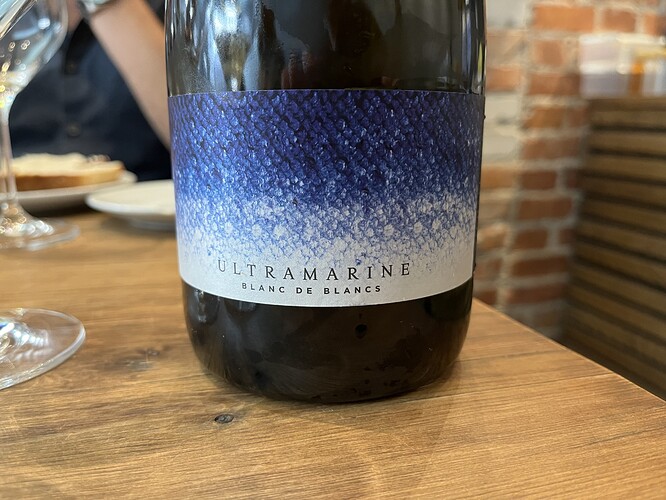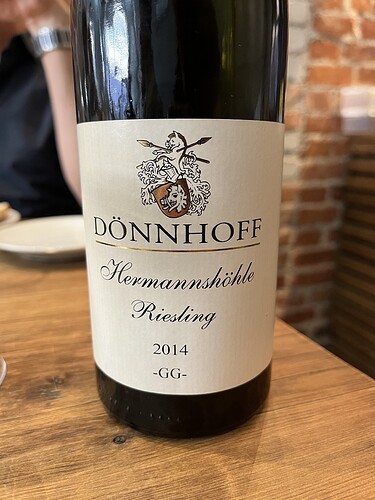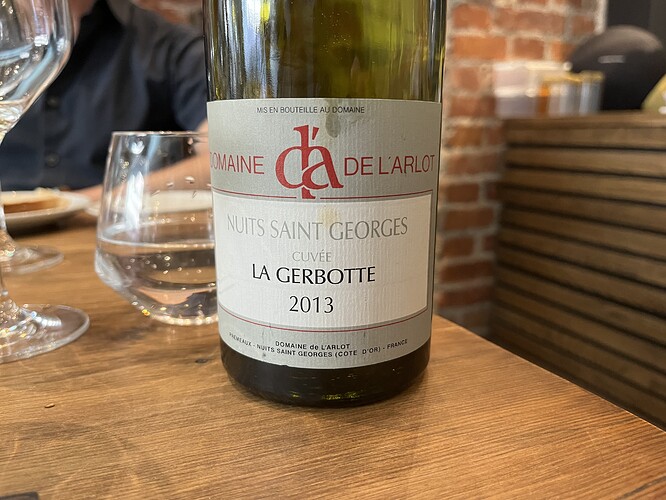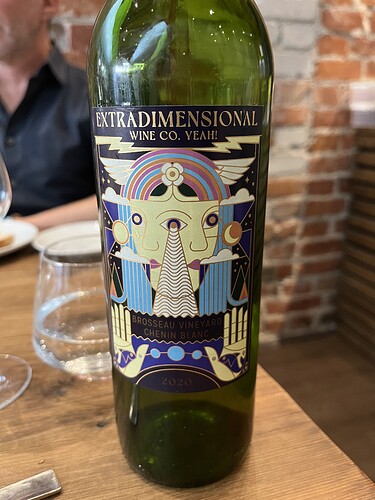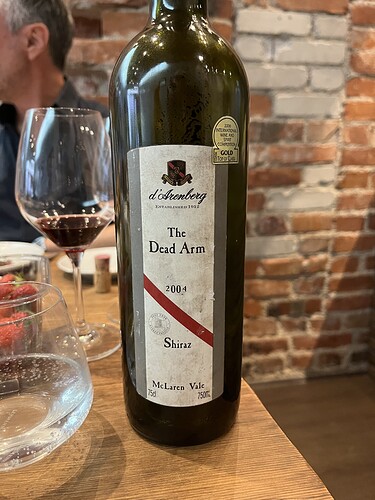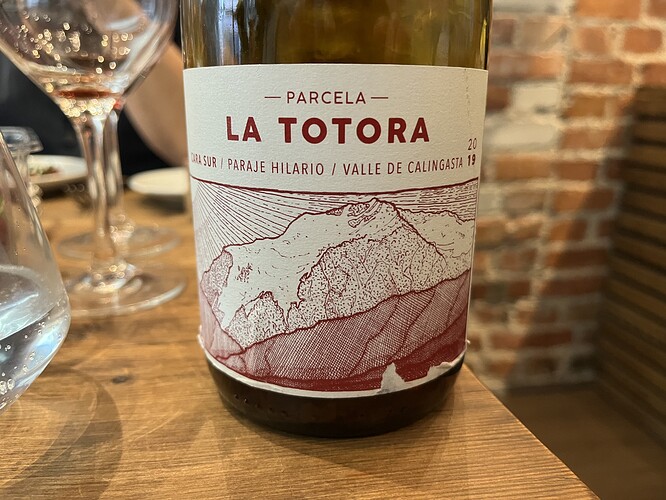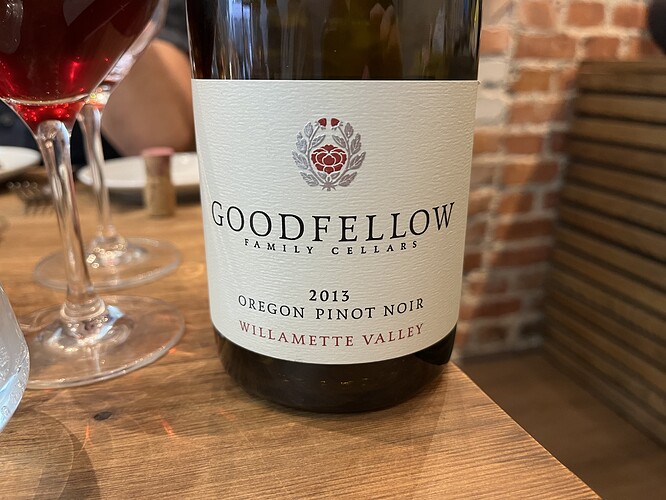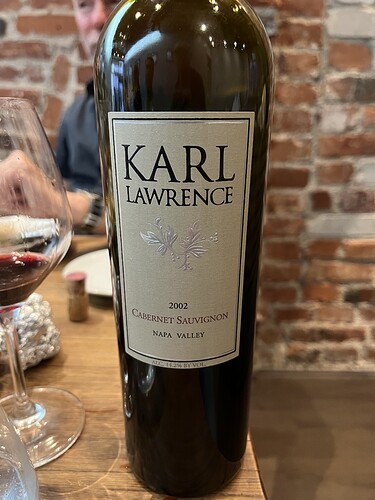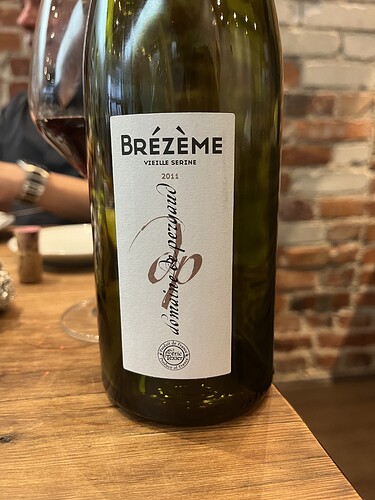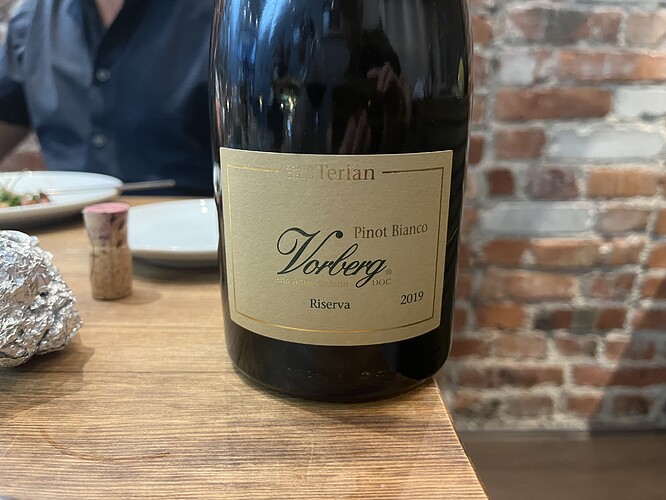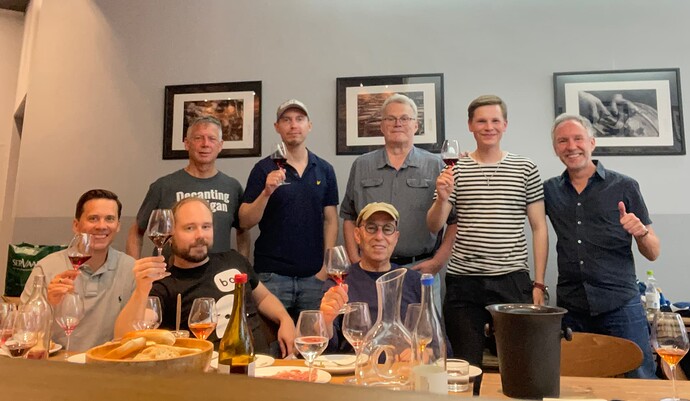Finally! I’ve been looking forward to writing this report, but due to the sheer amount of wines I’ve tasted, I’m now about a year behind in my backlog. Anyways, better late than never!
So, about a year ago @Mariano_Chiaramonte told us he’d be here and there in Europe during the summer 2024, so when it looked certain he was also going to visit Finland as well, I booked a tasting venue in one of the offsites in Helsinki center and we invited all the local Berserkers we could think of for a proper meetup!
So, in the end Mariano was joined by me, @AskoKassinen, @IlkkaL, @LenFox, @Mikko_R, @OtsoR, @Steve_Havas - and naturally a sizeable bunch of impressive wines to welcome Mariano to Finland! Naturally Mariano himself brought a handful of terrific wines, in addition to a few big boxes of fresh berries he had himself picked just moments before - from the neighboring Market Square!
Unfortunately I can’t recall all the topics we discussed during that evening, but fortunately I at least made notes on the wines we plowed through so at least I can describe here all the stuff we had! Well, apart from the Ultimate Final Drinks; when most of us had had enough and already headed home, I stayed behind, cleaning up the tasting venue, while the other few persistent people who still remained (namely Ilkka, Mikko and Mariano) went to the nearby Champagne bar to have a glass or two of Chartreuse - just to drive the point home, I guess! ![]()
The lineup for the evening:
- 2021 Jost Vineyards Tidal Bay - Canada, Nova Scotia (15.6.2024)
A blend of L’Acadie Blanc, New York Muscat, Geisenheim 318-57, Cayuga and Osceola Muscat (aka. Muscat Swenson) from Nova Scotia. 11% alcohol. Tasted blind.
Pale, youthful greenish color. The nose feels a bit Sauvignon Blanc-ish with its somewhat green-toned yet vaguely tropical aromas of vegetal herbs, some grassy greenness, a little bit of passion fruit and a hint of lemony citrus fruit. The wine feels dry-ish, crisp and balanced on the palate with a medium body and zippy flavors of fresh peach and tart passion fruit, some sharp Granny Smith apple tones, a little bit of grassy greenness, light sweeter honeyed nuances, a hint of lemony citrus fruit and a touch of tangy salinity. The high acidity makes the wine feel brisk and refreshing. The finish is crisp, fresh and a bit salty with a medium-to-moderately long aftertaste of passion fruit, some honeyed richness, a little bit of lemony citrus fruit, light steely mineral nuances and a vegetal hint of grassy greenness.
I've rarely found the dry North American (Northern US, Canada) hybrid wines particularly enjoyable. Some drinkable, but mainly only the sweeter ones close to dessert wine levels of residual sugar have been truly successful. That's why I was surprised how surprisingly serious and vinous this dry-ish to off-dry hybrid white was. My first guess was a Nova Scotian hybrid, but that was more because of the person who brought the wine; not because the wine was an obvious hybrid white. So in that sense this was a relatively good wine. It tasted like a young, inexpensive Sauvignon Blanc - ie. not really a wine up my alley, but still much better than your typical Nova Scotian whites. In a blind tasting, this could actually pass off as an actual wine made with Vitis vinifera grapes. Decent stuff. Priced according to its quality at 19,80 CAD (approx. 12-13€).
(87 points) - 2014 Dönnhoff Hermannshöhle Riesling Großes Gewächs - Germany, Nahe (15.6.2024)
13% alcohol.
Luminous neon yellow-green color. The nose feels fragrant with beautifully honeyed aromas of lemon marmalade, some candied ginger, a little bit of acacia honey, light petrolly nuances, a hint of peachy stone fruit and a floral whiff of white summer blossoms. As classic Riesling nose as they come. The wine feels dry, crisp and slightly oily yet firm on the palate with a medium body and focused flavors of ripe lemony citrus fruits and steely minerality, some tangy saline notes, a little bit of fresh peachy fruit, light developed notes of acacia honey and beeswax, a hint of key lime and a petrolly touch of diesel. The brisk, high acidity makes the overall feel refreshing and pretty incisive. The finish is crisp and lively with an intense aftertaste of lemony citrus fruits and stony minerality, some saline tones, a little bit of honeydew melon, light sharp notes of Granny Smith apple and a touch of crunchy white peach.
A wonderfully refreshing, structured and tasty GG Riesling that is still relatively youthful now, at 10 years age, showing only a little bit of honeyed richness and subtly petrolly undertones, otherwise brimming with youthful, citric fruit and cool minerality. The wine is now in its drinking window, but still some distance away from its apogee - I can imagine this wine will continue to evolve and improve for many more years. Drink or keep.
(94 points) - 2018 Ultramarine Blanc de Blancs Heintz Vineyard Sonoma Coast - USA, California, Sonoma County, Sonoma Coast (15.6.2024)
100% Chardonnay. Fermented spontaneously and aged in oak. MLF blocked. Bottled in the following spring and aged for approximately 40 months sur lattes. Disgorged in November 2022. 12,5% alcohol, dosage 2 g/l. Tasted blind.
Pale to medium-deep yellow-green color. A complex, somewhat evolved and attractively vinous nose with aromas of toasty autolysis, some bruised apple tones, a little bit of brioche, light smoky nuances, a hint of roasted almond and a touch of ripe, sweet-toned citrus fruits. The wine feels ripe and somewhat vinous yet pretty dry and firm on the palate with a medium body and bright flavors of ripe lemony citrus fruits and saline minerality, some sharp Granny Smith apple tones, a little bit of autolytic bread crust, light nutty notes of slivered almonds, a savory hint of umami and a sweeter touch of ripe white fruits. The acidity feels moderately high and the mousse comes across as silky, textural and quite persistent. The finish is long, dry and tangy with flavors of Granny Smith apple and salinity, some almondy notes of marzipan, light autolytic bready tones, a little bit of savory umami, a hint of bruised apple and a touch of leesy creaminess.
An attractive, serious and surprisingly toasty California fizz. With its combination of breadth and ripeness, somewhat toasty, autolytic overtones and evolved nuttiness, I was pretty sure the wine had a sizeable portion of Pinot Noir and it was most likely a Champagne. My first guess was a bit older Bollinger. However, with our guesses it soon became clear that we were way off - the wine was not as old and not as French as we imagined. I was honestly surprised that the wine wasn't older, as it seemed somewhat more evolved than a bubbly barely 6 years old should be. Nevertheless, seeing how the wine could pass off as a serious Champagne with some age, I'm not complaining. I'm quite surprised, though, how so many TNs in Cellartracker say the wine is funky, weird or cidery - there was nothing of the sort in this bottle! It was clean as a whistle from the first sniff to the last sip. An impressive effort and more or less worth the price at $80-85.
(93 points) - 2013 Domaine de L'Arlot Nuits St. Georges Cuvée La Gerbotte - France, Burgundy, Côte de Nuits, Nuits St. Georges (15.6.2024)
100% Chardonnay from 1er Cru Clos de l'Arlot. Fermented spontaneously, racked into oak barrels (20% new) midway through fermentation. Aged in oak barrels for 12 months, then racked into tanks and aged for another 3 months before the wine is bottled. 13% alcohol. Tasted blind.
Relatively youthful yellow-green color. Contrasting the appearance, the nose feels quite creamy and somewhat evolved with some woody tones, a little bit of melting butter, light juicy nectarine tones, a hint of toasty oak spice, a touch of sawdust and an aged whiff of something cheesy. The wine feels ripe, balanced and somewhat evolved with a medium-to-moderately full body and layered flavors of creamy oak and peachy stone fruits, some apple jam tones, a little bit of melting butter, light toasty oak nuances, a hint of saline minerality and a touch of leesy character. The rather high acidity keeps the overall feel firm and sufficiently structured. The finish is long, complex and somewhat evolved with an intense aftertaste of nutty wood and creamy oak, some bruised apple tones, a little bit of saline minerality, light leesy nuances, aged hints of wool and something cheesy and a touch of fresh stone fruits.
A nice, rich and moderately evolved Côte de Nuits white - in reality a 1er Cru, no less! The wine's appearance suggested that it was pretty young, but in the nose and on the palate the wine seemed much more evolved; it was as if the fruit had lost some intensity, making the woody tones and more evolved - somewhat cheesy and woolly - nuances get more precedence. Enjoyable with pleasant, evolved complexity - but I feel we might've caught the wine a little bit too late. I imagine the wine must've been more enjoyable with more fruit and while the wine will still continue to evolve and develop for many more years, I'm not sure if it is going to be for the benefit of the wine. I guess either this cuvée, or then just this particular vintage, might be of the rapidly evolving type?
(92 points) - 2020 Extradimensional Wine Co. Yeah! Chenin Blanc Brosseau Vineyard Chalone - USA, California, Central Coast, Chalone (15.6.2024)
100% Chenin Blanc from the Brosseau Vineyard. 12% alcohol. Total production 41 cases.
Somewhat hazy medium-deep neon yellow-green color. Even with some air the nose feels somewhat reductive and closed with aromas of gunpowder smoke, some pungent flinty notes, a little bit of Granny Smith apple, light lemony nuances, a hint of honeyed richness and a touch of fresh cantaloupe. The wine feels lively, crisp and rather reductive on the palate with a medium body and somewhat closed flavors of smoky reduction, some saline mineral notes, a little bit of tart Granny Smith apple, light stony nuances, a youthful hint of sour apple candies and a touch of beeswax. The high acidity lends good sense of freshness and structure. The finish is crisp, zippy and lively with a long aftertaste of Granny Smith apple, some lemony tones, a little bit of reductive flint smoke, light mineral notes of wet rocks, a hint of apple peel bitterness and a touch of waxy funk.
A nice, brisk and lively little Chenin Blanc that has a slightly wild and funky undertone, but comes across as fresh and lively on the surface. The overall feel was, however, quite reductive, and even with some aeration the wine didn't really open up. It didn't offer almost anything but smoky reduction upon opening, but came to show those fruitier nuances with air and patience. Nevertheless, if a wine is this reductive at almost 4 years of age, I feel like this is still a long way away from its apogee - I'd let the wine wait for a long time in a cellar. If opened now, the wine needs extended aeration; the 60 minutes the producer recommends doesn't seem to be nearly enough - unless you want to spend all those 60 minutes swirling the decanter!
(88 points) - NV Billecart-Salmon Champagne Brut Réserve - France, Champagne (15.6.2024)
An older bottle, although I've not idea of the exact age as the bottle bears no disgorgement date nor any information on the base vintage. However, the label looks different from the current one, including the "Maison Fondée en 1818" text in whitish pale gray color. 12% alcohol.
Medium-deep and slightly evolved yellow-green color. The nose feels somewhat evolved and a bit cheesy with aromas of leesy autolysis, some developed creamy tones, a little bit of sweet Golden Delicious apple, light nutty tones, a mineral hint of wet rocks and a touch of wax. The overall impression is maybe a bit dull and lacking in freshness. The finish is ripe, dry-ish and somewhat evolved with layered flavors of sweet Golden Delicious apple, some evolved creamy and nutty tones, a little bit of apple jam, light autolytic notes of toffee and leesy yeast, a hint of chalk dust and a touch of beeswax. Broad, soft and silky mousse. The moderately high acidity keeps the wine in balance, but the dosage shows a little bit more through than I'd want it to. The finish is long, dry-ish and crunchy with somewhat evolved flavors of creamy and nutty autolysis, some old cheesy tones, a little bit of apple jam, light notes of toffee, a hint of saline minerality and a touch of beeswax.
Usually I think that even the regular entry-level NVs of Champagne houses benefit from some aging, but it feels like this cuvée hadn't really improved - just evolved into something new. Lateral development quality-wise, if you will. The developed complexity here was pretty nice, but at the same time the overall feel was somewhat dull and even a bit cheesy, which sort of negated the benefits from the aging. Furthermore, the dosage seemed a bit on the high side here, making the wine feel conspicuously off-dry at times. All in all, this was good, but nothing particularly memorable.
(89 points) - 2019 Sabelli-Frisch Flame Tokay Lanterna Chandler Vineyard - USA, California, Central Valley, Lodi Mokelumne River (15.6.2024)
The sophomore vintage of this 100% Flame Tokay aka. Ahmeur Bou'Ahmer mainly from 120-yo vines in Chandler Vineyard, located in AVA Lodi Mokelumne River (supplemented with an additional half a ton of grapes from Lauchland Vineyard in Lodi). Although the producer calls this "skin-contact rosé wine", technically speaking this is as orange wine as they come. Fermented spontaneously and macerated with the skins for 3-4 weeks. Aged in old oak for 15 months. 12% alcohol.
Luminous amber color. The nose feels characterful and a bit evolved with aromas of caramel, some bruised apple, light toffee tones, a little bit of ripe apricot, a hint of floral spice and a funky touch of phenolic spice. Quite orange wine-ish overall impression. The wine feels dry, savory and textural on the palate with a medium-to-moderately full body and layered flavors of resinous phenolic spice and bruised apple, some apricot tones, a little bit of stony minerality, light savory notes of umami, a hint of ripe orange and a touch of caramel. The high acidity lends good sense of structure and freshness to the wine. The finish is long, savory and quite complex with a layered aftertaste of bruised apple and phenolic spice, some stony minerality, a little bit of apricot, light blood orange tones, a hint of caramel and a touch of savory umami.
A very nice, harmonious and quite clean orange wine with great sense of balance, depth and understated complexity. I can understand why Adam advertises the wine as a "rosé" wine, but from a technical point of view, this is pure orange wine: Skin maceration during - and not before - fermentation? Check; Multiple weeks of skin contact? Check; Orange color? Check. But no matter what the wine is, it is good. There's great sense of freshness, the wine is quite clean (those phenolic tones feel like that they are not only from the skin contact, but also from the minimal-interventionist winemaking) and the nuanced fruit profile is in the lead - not any funky weird notes. All in all, this is an interesting and well-crafted minimum-intervention orange wine that drinks mighty well right now but will at least keep - if not evolve - over a bunch of years more. Solid value at approx. $30. Recommended.
(92 points) - 2004 d'Arenberg Shiraz The Dead Arm - Australia, South Australia, Fleurieu, McLaren Vale (15.6.2024)
100% Syrah. The wine gets its name from the Eutypa Lata infection which afflicts some of the oldest d'Arenberg Shiraz vines. This disease can attack any part of the canopy, but often it attacks one "arm" of the vine, rendering it infertile and dead, making the remaining arm produce very concentrated fruit. The grapes are harvested between early March and late April, then transferred into open-top fermentors where the grapes are foot-trodden through 2/3 of the fermentation, after which the must is basked-pressed and racked to a mixture of (mainly) new and old French and American oak barriques to carry out the rest of the fermentation. Aged on the lees in these same barrels for 21 months, until the best barrels are selected for the final blending. Bottled unfined and unfiltered. 14,5% alcohol, 0,6 g/l residual sugar, 7,0 g/l acidity and pH 3,44.
Dense, dark and more or less fully opaque blackish color with a faint evolved maroon hue. The nose feels sweet-savory, somewhat evolved and quite complex with aromas of prunes, some sweet spices, light mocha notes of toasty oak, a little bit of blackberry jam, a hint of eucalyptus lift, a woody touch of savory oak spice and a volatile touch of nail polish or balsamico. The wine feels juicy, ripe and rich yet pretty savory on the palate with a full body and bold, somewhat extracted flavors of pruney dark fruit, some chocolatey mocha oak tones, a little bit of blackberry jam, light green notes of eucalyptus, sweet hints of wizened black cherries and raisins and a faint oxidative touch of soy sauce. The combination of the high acidity and ample, quite grippy tannins make the wine feel very firm and muscular. The finish is quite tannic, somewhat sweet-toned and a bit warm with a long, intensely flavored aftertaste of blackberry jam and prunes, some green eucalyptus tones, a little bit of toasty mocha oak spice, light plummy nuances, a hint of extracted bitterness and an oxidative touch of beef jerky.
A very impressive, powerful and quite extracted vintage of The Dead Arm. Even though the wine has always been impressively structured and concentrated in overall character, I felt this vintage was a bit more oaky and rather "blockbuster-ish" compared to most of the other vintages I've tasted. Even then, this was a remarkably balanced effort that didn't come across as heavy or clumsy as one could imagine - I guess the impressive structure of the wine must've helped a lot. I guess some further aging might help the wine to integrate those oak tones further with the fruit, but seeing as the wine is starting to feel already somewhat evolved and even subtly oxidative, I'd be wary letting the wine age much. Based on its performance now, I'd say the wine is now at its plateau of maturity. For how long is anybody's guess, but I'd consider drinking the wine sooner rather than later. All in all, good stuff.
(93 points) - 2019 Cara Sur Criolla Chica Parcela La Totora - Argentina, San Juan, Calingasta Valley (15.6.2024)
100% Criolla Chica aka. País aka. Mission from La Totora, an old parcel planted in the 1930's. 70% of the fruit destemmed, 30% whole cluster. Fermented spontaneously and macerated with the skins for 30 days. Aged on the lees in egg-shaped concrete tanks for 8 months. Bottled unfined and unfiltered. 13% alcohol. Total production 1200 bottles.
Pale, luminous and fully translucent cherry-red color with a subtly evolved, almost colorless pomegranate rim. The nose feels youthful and quite savory with aromas of dark forest fruits, some cherry tones, a little bit of wild strawberry, light spicy nuances, a hint of crunchy red berry and a touch of stony minerality. The wine feels silky, savory and quite airy on the palate with a medium body and surprisingly intense flavors of dark berries, some salt-cured meat, a little bit of sweet black cherry, light wild strawberry nuances, a hint of rustic earthiness and a touch of crunchy red plum. Quite balanced overall feel with moderately high acidity and ripe medium tannins that slowly pile up on the gums. The finish is ripe, savory and somewhat grippy with a juicy, long aftertaste of earth and wild strawberries, some dark forest fruits, a little bit of savory spice, a hint of tart red fruit and a touch of vague meaty character.
A balanced and tasty Criolla Chica that could maybe use a bit more acidity, but still manages to come across as harmonious and thoroughly enjoyable - partly due to the tannins that bring some welcome firmness to the texture. A very serious effort - something a Criolla Chica, Paìs or Mission usually is not. A positive surprise. It's hard to say whether the wine is peaking now or if it will evolve into something different with further age, but at least it is drinking really well right now.
(91 points) - 2013 Goodfellow Family Cellars Pinot Noir 'Mystery' Whistling Ridge Vineyard Ribbon Ridge - USA, Oregon, Willamette Valley, Ribbon Ridge (15.6.2024)
A special bottling made with only a single puncheon of Pinot Noir from Whistling Ridge. 100% whole cluster. Fermented spontaneously. Bottled under a DIAM 30 cork (as opposed to the DIAM 10 normally employed by the winery). 13,5% alcohol.
Quite translucent and slightly evolved cherry-red color with a subtly aged, vaguely rusty hue. The nose feels fragrant, attractive and somewhat sweet-toned with aromas of leather and tobacco, some cranberry marmalade, light cherry and wild strawberry tones, a little bit of savory spice, floral hints of dried flowers, a woody hint of savory oak spice and an evolved touch of beef jerky. The wine feels lively, vibrant and quite savory on the palate with a medium body and rather intense flavors of crunchy cranberries and tart lingonberries, some tobacco, light wild strawberry tones, a little bit of sour cherry bitterness, spicy hints of Pinosity and savory wood and a sweet, evolved touch of wizened dark berries. The wine shows terrific sense of structure with its high acidity and firm, moderately grippy medium-plus tannins. The finish is juicy, long and somewhat grippy with a savory aftertaste of cherries and crunchy cranberries, some tart lingonberry tones, a little bit of tobacco, light gravelly mineral notes, a hint of sour cherry bitterness and a developed touch of meaty umami.
A wonderfully serious, sinewy and beautifully evolved Oregon Pinot. To my understanding DIAM 30 is a closure meant for the longest-aging wines, assuring that the wine will reach that 30 years of age. However, seeing how the wine is starting to show some evolved signs, I'm not sure if this wine is built to last for 30 years - I'd say the wine is 5-10 years away from its peak, although it's certainly possible that the wine is still in a perfectly good shape at 30 years of age. I do like evolved wines, but I'd say this bottling is in an excellent shape right now and won't improve much with further aging. It would've been terrific to taste a bottle closed with a DIAM 10 cork to see how much of a difference the closure makes! Anyways, this was a terrific Pinot Noir; with its meaty and ripe cranberry tones it was very much Oregon, but with its sinewy, structural yet still very elegant overall feel I'd be happy to describe the wine as Burgundian. Recommended.
(93 points) - 2011 Eric Texier Côtes du Rhône-Brézème Vieille Serine Domaine de Pergaud - France, Rhône, Northern Rhône, Côtes du Rhône-Brézème (15.6.2024)
Made with organically grown Serine (a local Northern Rhône Syrah clone that is prone to diseases with unreliable yields, but producing higher-quality fruit) from +70 yo vineyards. Fermented spontaneously in whole bunches, macerated for 8-10 days, aged for +3 years months in neutral oak foudres. Bottled unfined and unfiltered. 12% alcohol. Tasted blind.
Quite deep and rather opaque black cherry color with a slightly evolved maroon hue and a pale, translucent rim. The nose feels fragrant, attractive and somewhat sweet-toned with layered aromas of ripe bilberries and peppery spice, some meaty tones, a little bit of juicy blackberry, light lifted notes of sweet balsamic VA, a floral hint of violets and maybe even garrigue and a touch of loose tobacco. The wine feels firm, vibrant and somewhat chewy on the palate with a medium body and savory flavors of meaty umami and peppery spice, some ripe blackberry-driven dark berries, a little bit of tobacco and leather, light stony mineral notes, a hint of wild strawberry and a touch of violets. The combination of high acidity and ample, moderately grippy tannins make the wine feel pretty sinewy and structure-driven. The finish is long, dry and moderately grippy with a nuanced and quite intense aftertaste of tart cranberries and brambly blackberries, some tobacco, light peppery tones, a little bit of wild strawberries, light stony mineral notes, a savory hint of meaty umami and a touch of olive.
An excellent, enjoyably stern and beautifully nuanced Serine that is now in a great spot; the wine isn't young anymore, but it hasn't really started to develop much aged tertiary qualities, either. There's sort of enough of both, making the wine feel still vibrant and relatively youthful, but at the same time having just about enough of those savory, leathery and meaty evolved tones as well. Structurally the wine is still pretty sturdy, showing no obvious signs of resolution. This wine will age wonderfully for many more years, but this is quite a banger at the moment, too. One of my favorite wines of the evening - and we had quite a many! Highly recommended.
(94 points) - 2001 Crissante Alessandria Barolo Capalot - Italy, Piedmont, Langhe, Barolo (15.6.2024)
A Cru Barolo made with fruit sourced from the Cru Capalot located in La Morra, planted in 1951. Macerated with the skins for 2 weeks in stainless steel, then racked in large botti casks in which the wine is aged for 24 months. 14,5% alcohol.
Old, translucent brownish color with a colorless rim. The nose feels smoky, old and oxidative with aromas of beef jerky, some pouch tobacco, a little bit of nutty rancio, light raisiny tones and a hint of soy sauce. The wine feels evolved, tired and somewhat sweet-toned on the palate with a rather full body and quite flat flavors of wizened black cherries and raisiny dark fruits, some sweet balsamic notes of VA, a little bit of earth, light nutty notes of rancio, a hint of gamey meat and a touch of soy sauce. The combination of quite high acidity and assertive, grippy tannins with the lack of fruit make the wine feel quite tough and unapologetic. The finish is long, oxidative and grippy with a rather savory aftertaste of dried black cherries, some beef jerky, light balsamic notes of VA, a little bit of nutty rancio, a hint of earth and a touch of soy sauce.
This bottle was completely goners. The bottle which I tasted a few years ago seemed more advanced than I would've expected a 20-yo Barolo to be, but I really didn't expect the wine to be completely in pieces just a few years later. This was a big disappointment. Waste of money at 33,10€.
(NR/flawed) - 2002 Karl Lawrence Cabernet Sauvignon - USA, California, Napa Valley (15.6.2024)
14,2% alcohol. Tasted blind.
Dense, fully opaque and still relatively youthful blackish-red color. The nose feels ripe, dark-toned and somewhat evolved with rich aromas of sweet blackcurrants and blueberries, some wizened dark plums, light cigar tones, a little bit of new leather, a hint of balsamic VA, a touch earth and a whiff of toasty oak spice. The wine feels juicy, rich and harmonious on the palate with a full body and bold flavors of sweet blackcurrants and succulent dark plums, some pipe tobacco tones, a little bit of old leather, light balsamic tones, a herbaceous hint of leafy greenness and a touch of earth. The overall feel is pretty firm but slowly getting rather resolved with its moderately high acidity and ripe, quite supple medium tannins. The finish is ripe, sweetly-fruited and somewhat grippy with a long, nuanced aftertaste of pipe tobacco and wizened blackcurrants, some plummy tones, a little bit of old leather, light woody notes of savory oak spice, a hint of balsamico and a toasty touch of mocha oak.
A rather big, harmonious and tasty Napa Cab that is in a great spot right now. I can imagine this might've been quite a burly and perhaps also pretty oaky fellow in its youth, but now the oaky notes have subsided wonderfully and while the fruit profile is starting to show some tertiary dried-fruit qualities, it retains enough youthful vibrancy to keep the wine from feeling too old or tired. Although the nose was more or less only about rich fruit aromatics, I was happy to pick up some leafy nuances on the palate that brought in a lovely counterpoint to the sweet-toned fruit flavors. Good stuff.
(92 points) - 1999 Fery-Meunier Charmes-Chambertin - France, Burgundy, Côte de Nuits, Charmes-Chambertin Grand Cru (15.6.2024)
A Grand Cru Charmes-Chambertin from a négociant which I'm not sure if is in operation anymore. 13,5% alcohol.
Dark, somewhat translucent and moderately evolved rusty maroon color with a pale caramel rim. The nose feels quite evolved but also pretty attractive with aromas of wizened cherries, some leathery tones, a little bit of loose tobacco, light smoky notes of tar, a hint of game, a touch of dried dark berries and a whiff of salty liquorice powder. The wine feels evolved, silky and slightly oxidative on the palate with a medium body and quite aged flavors of savory meaty umami and wizened black raspberries, some earthy tones, a little bit of smoke, light gamey nuances, oxidative hints of prunes and soy sauce and a touch of ripe cherry. The overall feel is pretty balanced, thanks to the quite high acidity and medium tannins. The finish is long, aged and savory with a somewhat tertiary aftertaste of meaty umami and tobacco, some sweeter notes of wizened cherries and raisiny dark fruits, a little bit of game, light smoky nuances, a hint of earth and a touch of old leather.
A sophisticated and harmonious Grand Cru that is already a bit over the hill. Not badly, though - the wine is still quite complex and thoroughly enjoyable. It is just getting obvious that the oxidative qualities have crept in a little while ago and those soy sauce nuances are now slowly overwhelming the finer nuances, making the wine feel a bit tired. I can imagine this must've been a prettier and more vibrant wine some years ago, but I think this probably wasn't the most impressive Grand Cru out there, if it is already starting to fade away before its 25th birthday. All in all, a fine wine, but not one to blow your socks off.
(90 points) - 2021 Extradimensional Wine Co. Yeah! Mourvèdre Old Vines Evangelho Vineyard - USA, California, San Francisco Bay, Contra Costa County (15.6.2024)
100% Mourvèdre from the Evangelho Vineyard. Vinified according to a pretty minimal interventionist philosophy. 12,7% alcohol. Total production 47 cases.
Youthful, somewhat translucent and slightly inky blood-red color. The nose feels youthful, sweet and even a bit primary with nuanced aromas of blueberries and sweet plummy fruit, some blackcurrant marmalade tones, a little bit of volatile lift, light bretty notes of phenolic spice, a hint of cherry juice, a touch of gasoline and a whiff of red licorice. The wine feels youthful, bright and lively on the palate with a medium body and intense but also quite primary flavors of dark forest fruits and arctic bramble, some crunchy notes of fresh red plums, a little bit of cherry juice, light licorice tones, a hint of phenolic funk and a touch of tart lingonberry. The overall feel is surprisingly structured and tightly-knit for such a relatively light-bodied wine with its high acidity and ample, moderately grippy tannins. The finish is dry, crunchy and somewhat grippy with a long, quite intense aftertaste of tart lingonberries and cranberries, some darker-toned blackberry notes, a little bit of candied primary fruit, light crunchy notes of fresh red plums, a funky hint of phenolic spice and a faint touch of lifted VA.
A remarkably fresh, lively and crunchy effort for a Mourvèdre - very unlike any French Mourvèdre, Spanish Monastrell or new world Mataro I've ever tasted! To be frank, I imagined a Mourvèdre picked as low potential alcohol as this would be still underripe and even vegetal, but this wine tastes fully ripe in that sense - just a bright and crunchy cool-climate wine! I'm not sure if this is "varietally correct" in the sense that there is basically nothing that would make me think Mourvèdre, but this was a lovely wine in its own right; good sense of structure, crunchy fruit flavors and even a tiny bit of phenolic funk that only adds to the complexity without obfuscating anything. Perhaps the biggest downside here was the young age of the wine - the fruit flavors still had some candied primary notes, making the wine feel pretty generic and banal new world wine at times. However, this seems like something that will disappear with bottle age, so let the wine wait for another 5-7 years to make sure those candied notes disappear. With this much fruit intensity and structure, I'm sure this wine will continue to age and improve effortlessly for a good handful of years. Fun stuff, recommended.
(92 points) - 2019 Cantina Terlan Pinot Bianco Terlano Riserva Vorberg - Italy, Trentino-Alto Adige, Alto Adige, Terlano (15.6.2024)
The grapes are harvested from the Cru Vorberg, harvested in the first week of September. Fermented in old 7000 to 3000-liter oak casks, full MLF, aged for 12 months in oak casks. 14% alcohol, 0,7 g/l residual sugar and 6,1 g/l acidity. Tasted blind.
Rather youthful yellow-green color. The nose feels rich, waxy and immediately just so very Italian with quite youthful aromas of mirabelle plums and slivered almonds along with juicy notes of white peach, some extracted spicy tones, a little bit of honeysuckle, light stony mineral notes, a hint of honeydew melon and a touch of something waxy. Lots of everything here. The wine feels quite ripe, rich and a bit oily yet still wonderfully balanced on the palate with a full body and intense, concentrated flavors of spicy red apple and spicy, extracted minerality, some honeydew melon tones, a little bit of juicy apricot and mirabelle plum, light floral nuances of honeysuckle, a hint of white peach and a mineral touch of wet rocks. The wine is high in acidity, although it might not be obvious immediately, as the voluminous body and the ripe fruit flavors mask away quite a bit of the acidic zip. However, the overall feel is very firm and structured despite the size and ripeness. The finish is rich, long and juicy with a nuanced, somewhat sweet-toned aftertaste of peaches and fresh white fruits, some stony mineral notes, a little bit of honeysuckle, light extracted spicy tones, a hint of mirabelle plum and a touch of something waxy.
A very youthful and quite hefty but also very firm, balanced and promising vintage of Vorberg. The wine might be quite big and burly now, but it shows great promise for future potential with its combination of intense fruit flavors and impressive structure. Although fully enjoyable already now, I feel like this wine could really use another 6-10 years to realize its potential fully. Highly recommended.
(93 points) - 2001 Domaine du Pégau Châteauneuf-du-Pape Cuvée Laurence - France, Rhône, Southern Rhône, Châteauneuf-du-Pape (15.6.2024)
Cuvée Laurence is in every other way identical to the Pégau Cuvée Réservée, except for its twice as long aging regime. It is typically a blend of Grenache (80%), Syrah (6%), Mourvèdre (4%) and all the other 10 permitted varieties (total 10%). All the grapes are vinified in whole bunches. Fermented spontaneously, macerated with the skins for 12 days. Aged for 4 years in old 5000-liter oak casks. 14,5% alcohol.
Quite old and moderately translucent pomegranate color with an oxidative brownish hue. The nose feels old, pungent and somewhat oxidative with aromas of soy sauce and nutty rancio, some hoisin sauce, light syrupy tones, a little bit of pruney dark fruit, a hint of earth and a touch of tobacco. The wine feels ripe, warm and moderately oxidative on the palate with a full body and savory, somewhat extracted flavors of soy sauce, some raisiny tones, a little bit of nutty rancio, light gamey nuances, a hint of tobacco and a touch of sun-baked earth. The structure relies more on the rather tough and still pretty grippy tannins than on the medium-to-moderately high acidity. The finish is savory, grippy and oxidative with a long, tired aftertaste of soy sauce, some prunes and dried figs, a little bit of raisiny dark fruit, light earthy tones, a hint of tobacco and a touch of nutty rancio.
I guess back in the day the wine must've been quite a big and impressive effort for a Pape. However, today the wine is starting to push daisies - not only was this bottle way too deep in the oxidized territory, but also more or less all the recent notes in Cellartracker say the same thing. Very little life remains here. If there are still some bottles of this somewhere, I recommend drinking them sooner rather than later - the days for this wine are numbered.
(NR/flawed) - 1999 Chateau Musar - Lebanon, Bekaa Valley (15.6.2024)
14,15% alcohol, 5,97 g/l acidity, 0,95 g/l VA, pH 3,79. Double-decanted a few hours before tasting the wine. Tasted blind.
Slightly translucent cherry-red color that doesn't look young nor particularly old. The nose is nuanced and very attractive with quite intense aromas that seem - just like the appearance - not youthful nor particularly old. There are notes of ripe red plums and sunny cherry marmalade-driven sweet fruit, some volatile notes of balsamico or nail polish, a little bit of juicy blackcurrant, light funky notes of old leather, a hint of strawberry jam and a touch of wizened dark fruits. The wine feels ripe, juicy and quite savory with a full body and vibrant, intense flavors of sweet black cherries and juicy blackcurrants, some funky notes of leather, a little bit of pipe tobacco, light sweeter notes of ripe figgy fruit and marmeladey cherry, volatile hints of balsamico or nail polish and a touch of gamey meat. The overall feel is firm and structured, thanks to the rather high acidity and still moderately grippy medium-plus tannins. The finish is silky, surprisingly fresh and moderately tannic with a long, sweet-yet-savory aftertaste of cherry marmalade, some plum jam, light strawberry tones, a little bit of leathery funk, sweet hints of dried figs and raisins and a lifted touch of balsamic VA.
This is consistently one of the best vintages of Musar for I don't know how long. This was my 6th bottle of this vintage I've tasted within the last 10 years and apart from one prematurely oxidized bottle, this has been always an absolute banger. Although not as funky as some of the vintages from this period, this is still immediately identifiable for a Musar with its ripe and sunny yet still remarkably fresh and balanced overall fruit profile and a sweet, lifted backdrop of perceptible yet not excessive VA. Although the wine isn't young anymore, the overall feel is still anything but old or tired - I'm sure this vintage will continue to sing for at least another decade, if not for much longer. I don't know if the wine will get qualitatively better from here with additional aging, but I'm sure the wine will continue to evolve into some kind of direction for a good while before its inevitable decline. At 30,59€ this has been a screaming bargain.
(95 points) - 1983 Château Guiraud - France, Bordeaux, Sauternais, Sauternes (15.6.2024)
Typically a blend of Sauvignon Blanc (2/3) and Sémillon (1/3). Aged in predominantly new oak barriques. Labeled as "11-14% ABV".
Pale-to-medium-deep bronze color. The nose feels rich, complex and evolved with sweet aromas of acacia honey and caramel, some dried peach tones, a little bit of tinned pineapple, light saffron notes, a floral hint of honeysuckle, a creamy touch of panna cotta and a whiff of vanilla. The nose isn't young by any means, but I'd still say the impression is that of a wine younger than +40 years old. The wine feels rich, oily and complex on the palate with a full body and sweet flavors of acacia honey and dried peach, some creamy panna cotta tones, a little bit of saffron, light caramel nuances, oaky hints of vanilla and savory wood spice and a touch of tinned pineapple. The moderately high acidity isn't really sufficient enough to lend much freshness to the wine or offset any of the sweetness, but it does still good job at making the wine feel balanced and pretty structured. The finish is long, sweet and complex with a layered, sweet-yet-slightly savory aftertaste of honeyed peach and dried pineapple, some overripe apricot, light caramel tones, a little bit of savory wood spice, a hint of saffron and a creamy touch of panna cotta.
A beautifully aged, complex and harmonious Sauternes at optimum drinking window. So many layers of flavor here and the balance is just on point. The wine is starting to get quite tertiary, but there's enough life and energy here to keep things remarkably vibrant and surprisingly fresh for the age. I can't say for certain whether the wine has reached its peak and is now at its plateau of maturity or if it is capable of still aging and improving from here, but for immediate consumption this is now in a perfect spot. Absolutely fantastic stuff, very highly recommended.
(96 points) - 2010 Albert Gessinger Zeltinger Sonnenuhr Riesling Auslese ** Alte Reben Caldo Infernale - Germany, Mosel Saar Ruwer (15.6.2024)
A biodynamically farmed Riesling from a particularly hot plot in the Zeltinger Sonnenuhr vineyard known as "Kalk". The wine is aged for 2 years in old 1000-liter Fuders. 8,5% alcohol, 128 g/l residual sugar, 13,6 g/l acidity.
Intense neon green color. The nose feels sweet, concentrated and very attractive with intense aromas of lemon marmalade and candied ginger, some developed creamy tones, a little bit of fresh pineapple, light mineral notes of wet rocks, a hint of overripe nectarine, a touch of apple sauce and a whiff of dried yellow fruits. Tons of everything here. On the palate the first thing that hits you is the jolt of acidity that simply wakes your tastebuds for what is coming. The overall feel is concentrated, quite sweet and just ridiculously intense with a medium-to-moderately full body and immensely focused flavors of lemon juice and fresh pineapple, some developed creamy tones, a little bit of candied ginger, light stony and saline mineral notes, a hint of pithy grapefruit bitterness and a still youthful touch of sour apple candies. Although the wine is technically very sweet, the outrageous amount of acidity offsets most of the sweetness from the residual sugar, making the wine feel bracingly incisive and immensely structured in the process. The finish is crisp and lively with an extremely long aftertaste of lemony citrus fruits, some candied ginger tones, a little bit of apple jam and honey, light creamy notes of custard, a hint of pithy grapefruit bitterness and a touch of tangy salinity.
This was the 18th bottle of 2010 Caldo Infernale I've tasted and it still remains as one of the most extraordinary Rieslings I've tasted; the balance between the racy acidity - the hallmark of the 2010 vintage in Mosel - and the extraordinary, super-concentrated fruit is something very few sweet wines ever manage to attain. At some point I was worried if this wine was not going to be as long-lived as I had hoped for as the wines seemed to be evolving at a faster pace than I had anticipated, but this bottle from my personal stash blow off all my concerns; if anything, the wine seemed a bit younger than most 2010 Rieslings at this age! At 25€, this has been simply extraordinary value.
(98 points)
Posted from CellarTracker
To conclude; if you happen to be visiting Finland (well, the Helsinki region) - let us know. We are always happy to get together and open some terrific wines whenever a good opportunity arises! Of course we gladly taste any new interesting wines you might want to bring with you, but also remember that bringing wine with you is absolutely not necessary - we have more than enough good wine to keep any thirsty wino happy!

